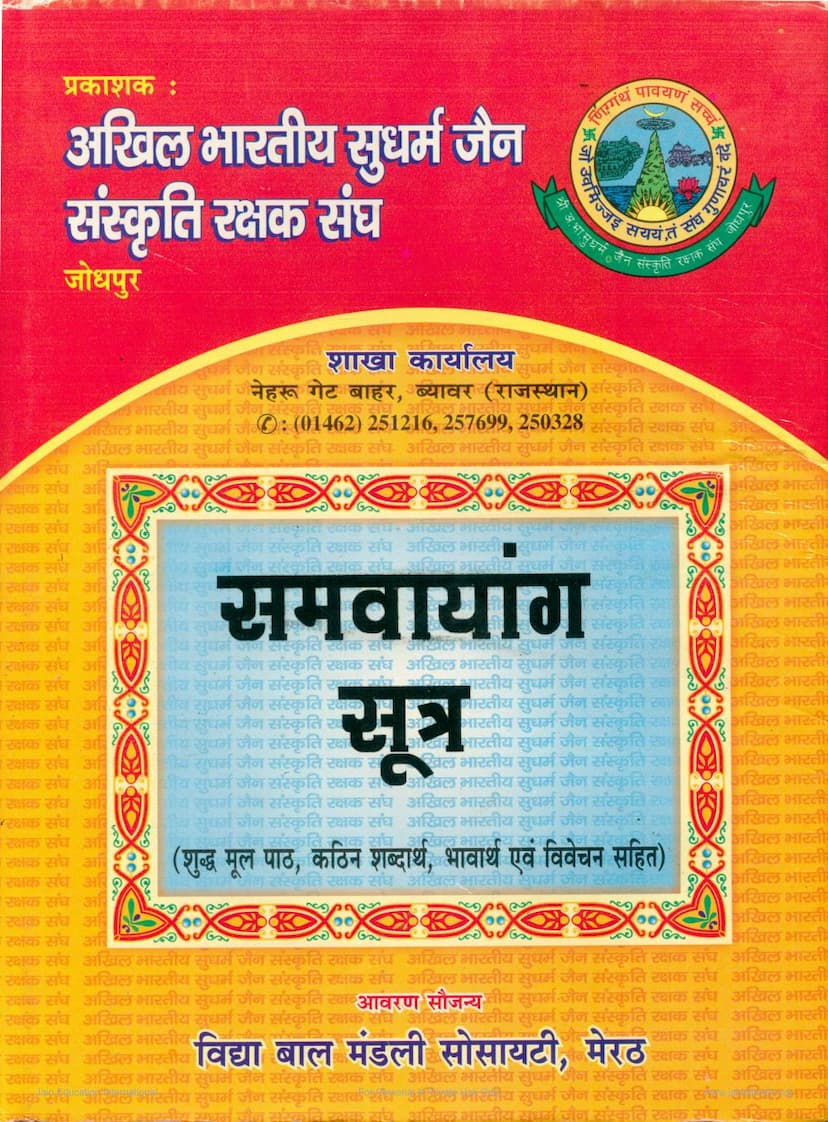Samvayang Sutra
Added to library: September 2, 2025

Summary
Here's a comprehensive summary of the Samvayang Sutra, based on the provided text:
The Samvayang Sutra is the fourth Anga (limb or chapter) of the Jain Agamas, which are the canonical scriptures of Jainism. This particular edition, published by Akhil Bharatiya Sudharm Jain Sanskruti Rakshak Sangh, Jodhpur, is presented with the original Sanskrit text, explanations of difficult words, a summary of its meaning, and detailed discussions.
Core Jain Philosophy and the Role of Agamas:
- The text begins by stating a fundamental Jain principle: every soul possesses infinite, inherent spiritual power, equal to that of a Omniscient and All-Seeing Vitaraga (one free from attachment and aversion). This power is currently suppressed by afflictive states of mind like attachment and aversion.
- This spiritual power can be unveiled through pure, disciplined practices as prescribed by the Vitaraga beings.
- The teachings of these Vitaraga beings, compiled by their learned disciples (Ganadharas), are considered valid scripture (Agam, Aptavachan, Shastra, Sutra).
- The current 32 Agamas are believed to be the compilation of the teachings of Lord Mahavir, the 24th Tirthankara, and the enlightened Acharyas who preceded him.
- In ancient times, Agamas were preserved through oral tradition by memorization. Later, around 980 years after Lord Mahavir's Nirvana, they were finally transcribed during a council led by Acharya Devardhigani Kshamashramana to prevent their loss due to memory degradation over time.
- Despite challenges like the loss of the Dvadasang (twelfth Anga, Drishtivad), variations in interpretations, and limitations of memory, the currently available scriptural wealth is considered sufficient for the liberation of earnest souls.
The Samvayang Sutra: Its Position and Content:
- The Samvayang Sutra is the fourth of the twelve Anga Sutras.
- The Nandi Sutra provides a brief outline of the Samvayang Sutra's content, stating that it deals with the arrangement or combination ("Samavaya") of souls and non-souls, self-time and other-time, worldly and unworldly realities, and the principles of rightness (Samya).
- The Samvayang Sutra enumerates and classifies various spiritual and worldly principles and entities from one up to one hundred, and beyond, into categories. It describes them based on attributes like substance (dravya), space (kshetra), time (kala), and state (bhava).
- This comprehensive classification encompasses topics from the nature of soul and non-soul to cosmology, mathematics, history, ethics, and more. The text highlights that the Samvayang Sutra, by compiling such a vast array of subjects, serves as a unique lexicon.
- Knowledge of the Sthananga and Samvayang Sutras is considered essential for aspiring Acharyas and Upadhyayas (teachers) in Jainism, as these two texts provide a foundational understanding of numerous essential topics.
Key Features of this Edition:
- Comprehensive: It includes the pure original text, difficult word explanations, summaries of meaning, and detailed discussions where necessary.
- Scholarly Translation: The translation is attributed to Pandit Shri Ghevarchandji Banthiya "Veerputra," who was a distinguished scholar in Jain philosophy, grammar, and scriptures.
- Editorial Rigor: The text underwent review and revision by respected individuals like Parasmal Chandaliya, Jaswantlal J. Shah, and Dhanrajji Badero to ensure accuracy and clarity.
- Community Support: The publication is a result of the collective effort of the Akhil Bharatiya Sudharm Jain Sanskruti Rakshak Sangh, with financial support from individuals like Shri Jaswantlal Bhai Shah of Mumbai.
Structure and Content (as indicated by the Table of Contents):
The Samvayang Sutra is structured into numerous "Samavayas" (arrangements or categories), proceeding from one to increasingly higher numbers (e.g., first Samavaya, second Samavaya, up to the hundredth Samavaya, and beyond). The table of contents reveals a vast scope, including:
- Enumerations and Classifications: Covering numbers from one upwards, dealing with various entities and concepts.
- Categories of Existence: Discussions on souls, non-souls, substances like Dharma, Adharma, Akash, Pudgala, and their properties.
- Cosmology: Descriptions of the universe (Loka), non-universe (Aloka), celestial bodies (Jyotishkas), hellish realms (Narakas), and heavenly realms (Vimanas), including their lifespans (sthiti), lifespans of inhabitants, and dimensions.
- Time and Space: Detailed explanations of temporal units (e.g., Palyopama, Sagaropama) and spatial extents (e.g., Yojanas).
- Ethics and Conduct: Principles of right conduct, vows (Mahavratas), restraints (Samitis), and conduct rules (Guptis).
- Metaphysics and Philosophy: Discussions on cause and effect, bondage (bandha), liberation (moksha), influx (asrava), and cessation of influx (samvara).
- Historical and Biographical Accounts: Details about Tirthankaras, Chakravartis (universal monarchs), Baladevas, Vasudevas, Pratīvasudevas, and their lineage, as well as the descriptions of the time periods of progression and regression of cosmic joy and sorrow (Utsarpini and Avsarpini periods).
- Other Subjects: The text also touches upon topics like auspicious and inauspicious omens, different types of knowledge (Jnana), spiritual states (Leshya), and various religious practices.
Key Takeaways:
The Samvayang Sutra is a highly systematic and encyclopedic text within Jainism. Its primary purpose is to classify and enumerate a vast array of spiritual, cosmological, ethical, and historical elements, providing a structured framework for understanding the Jain worldview. The emphasis on numerical categorization highlights the Jain emphasis on knowledge and precise classification as paths to spiritual understanding and liberation. The detailed lists of lifespans, dimensions, and occurrences demonstrate the Agamas' attempt to provide a comprehensive and ordered account of the universe and its workings.